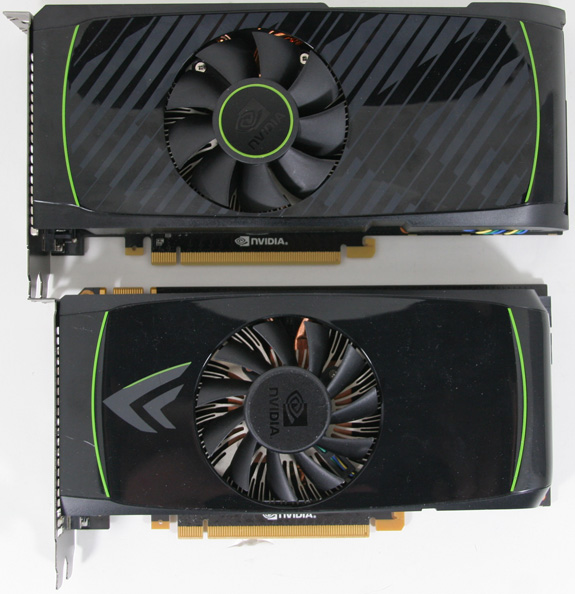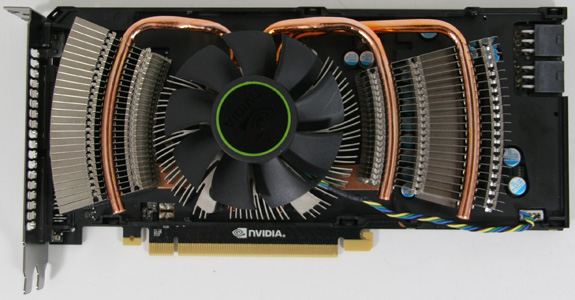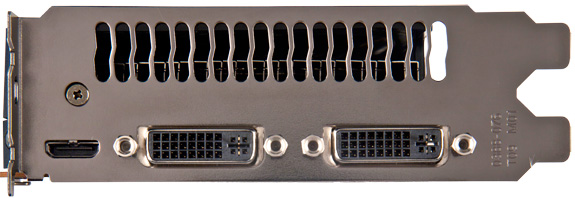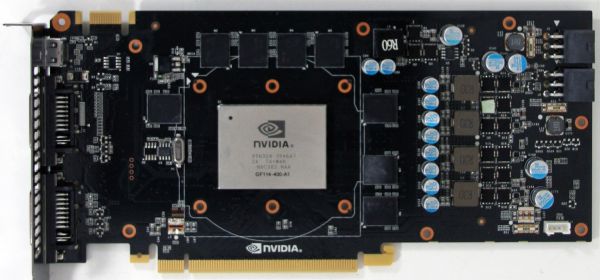NVIDIA's GeForce GTX 560 Ti: Upsetting The $250 Market
by Ryan Smith on January 25, 2011 9:00 AM ESTMeet The GTX 560 Ti
As we mentioned previously, GF114 is so similar to GF104 that it’s even pin compatible, leading to a number of NVIDIA’s partners simply reusing their GTX 460 designs. So long as you can provide the extra 10W and handle the extra heat, a GTX 460 design is 1 GF114 away from being a GTX 560 Ti. And while we’re going to see a number of familiar designs from NVIDIA’s partners, that hasn’t stopped NVIDIA from going back to the drawing table for the GTX 560 Ti’s reference design. As a result while the reference card is similar to the GTX 460 reference card, it has also clearly been enhanced to not just handle the slightly higher power requirements but to go above and beyond.

Top: GTX 560 Ti. Bottom: GTX 460 1GB
Since so much of this article is based on comparisons to the GTX 460, let’s start there. GTX 460 was an 8.25” long card with a center-mounted fan using a half-enclosed shroud, sitting on top of a slightly odd dual-heatpipe heatsink. By using a center-mounted fan, NVIDIA went with a design that recirculates some air in the case of the computer instead of a blower that fully exhausts all hot air. The advantage of the recirculating design is that it’s quieter than a blower, but the cost is that it’s more reliant on case ventilation. In a well-ventilated case like our Thermaltake Spedo, this worked out well to the GTX 460’s advantage, resulting in a very cool, very quiet card. In fact the only real problem we encountered with NVIDIA’s design was on the similarly designed GTS 450, where were discovered the downside to the fact that the PCB wasn’t securely mounted to the shroud on all corners.
For the GTX 560 Ti, NVIDIA has taken this same basic design and has effectively built it bigger. Overall the GTX 560 Ti is now bigger, measuring a full 9” long. This looks to be a result of both a larger heatsink, and of additional components laid out on the PCB (presumably to meet the higher power requirements). Anchoring that 9” PCB is a baseplate, nearly identical in style to the one we see on the GTX 580 and GTX 570. As a simple metal plate the baseplate provides some heatsink capacity for any small components it sits over (e.g. MOSFETs) but it also provides mount points for OEM computers that further bolt down their video cards, and it provides structural stability to the now longer card; the GTX 560 Ti won’t bend, and trust me I’ve tried.

Cooling is being provided by a heatsink & fan combination similar to the GTX 460. Like everything else about the card this has been scaled up a bit to meet the higher power requirements, with a slightly longer heatsink attached to the GPU using 3 copper heatpipes. Sitting over this is an equally similar partially open shroud which directs air out the front and the rear of the card. For lack of better wording the shroud is slightly more enclosed on the GTX 560 Ti than the GTX 460, so we suspect at least a trivial amount of additional hot air gets exhausted towards the front of the card outside of the case, as opposed to on the GTX 460. Finally the shorud is once more concave, resulting in the 80mm fan sticking up above the shroud slightly for better airflow.
Looking at the bare PCB, as was the case with the GF104 GPU, GF114 is capped with a metal heatspreader. Meanwhile the memory on our sample is 5Gbps Samsung GDDR5, which is rated well beyond the 4004MHz the card ships as. As we’ve mentioned before the limitation becomes the memory controller and the memory bus, long before it becomes the GDDR5 memory itself. Providing power for all of this is a pair of 6pin PCIe power sockets, which are located on the rear of the card. We’re not fans of rear mounted plugs, particularly on longer cards. We would have liked to see NVIDIA rotate them upwards given the GTX 560 Ti’s extended length.
Meanwhile display connectivity remains unchanged from the rest of the GTX 400/500 series. NVIDIA provides 2 dual-link DVI ports and a mini-HDMI port; however only 2 displays can be driven by a single card. Through SLI a second card can be hooked up to drive a 3rd and 4th display, necessary among other things for NVIDIA/3D Vision Surround. As with the GTX 460, a single SLI connector is provided, allowing 2-way SLI.

Overall while the GTX 560 Ti isn’t necessarily overbuilt, it’s certainly more than we were expecting for just a 10W increase in power consumption. Whether NVIDIA actually needed a card like this or if they have a specific goal in mind we’re unsure, but it’s quite a bit more complex a card than the GTX 460. No doubt this drives part of the GTX 560 Ti’s higher price, but given that NVIDIA’s partners can sell GTX 460 1GBs for nearly $100 less, there’s probably a good profit to be had with this card even with its additional complexity. Or to put things another way, even with the additional complexity we suspect NVIDIA has plenty of room to lower prices as the competitive market dictates.
If you’ve made it this far then no doubt the name has caught your attention. NVIDIA’s product naming has been complex (if not exploitive) lately, and GTX 560 Ti doesn’t change that. Unlike GF100 to GF110, GF104 to GF114 brings with it absolutely no architectural changes whatsoever. Thus GTX 560 is nothing more than a GTX 460 with more functional units and a higher clockspeed based on a tweaked chip ; hardly deserving of a whole new generation in name. But we knew this was coming the moment we saw the GTX 580, so here we are.
Furthermore NVIDIA’s affinity for long names continues to grow at roughly the same pace as the length of their product names. Due to NVIDIA’s disabling of ROPs on the GTX 460 the memory size was an unofficial suffix, as cards with 768MB would have fewer ROPs and less memory bandwidth, leading to performance even lower than what the missing 256MB on its own would lead to. The good news is that NVIDIA has improved on this by ditching the memory suffixes (memory size is no longer used to indicate the number of ROPs), while the bad news is that suffixes are here to stay.
While NVIDIA had used suffixes for a long time, starting with the 200 series however suffixes became the prefix, leading to GTX 285, GTS 250, GT 430, etc. After a two and a half year break from suffixes, they’re back. In a rather transparent attempt to capture the goodwill and fame of the company’s GeForce 3 Ti and GeForce 4 Ti products, NVIDIA is resurrecting the Ti suffix for the GTX 560 Ti. At this point in time it doesn’t mean anything, but if the GTX 460 is anything to go by, at some point we’d expect to see a lower-end GeForce GTX 560 <insert suffix here> to flesh out NVIDIA’s lineup. It goes without saying that we’d rather just have model numbers that clearly denote the performance ranking of cards, e.g. GTX 560, GTX 555, etc, but then we’re hardware enthusiasts and not marketing directors.











87 Comments
View All Comments
ImSpartacus - Tuesday, January 25, 2011 - link
Page one, first chart, the 560 Ti is "$149" instead of "$249".Although, I kinda prefer the former.
alcortez - Tuesday, January 25, 2011 - link
...wow a 460 for negative $160.I want in on that. ;)
loubarouba - Tuesday, January 25, 2011 - link
lol thats definitely an approximately sign (~)...unless of course i was late and has already been edited to that..7Enigma - Tuesday, January 25, 2011 - link
Listed at $149 when you meant to write $249.7Enigma - Tuesday, January 25, 2011 - link
1st chart to clarify.vol7ron - Tuesday, January 25, 2011 - link
I think ImSpartacus beat you to it ;)ImSpartacus - Tuesday, January 25, 2011 - link
Yeah, I was secretly hoping to be the first to mention that. I feel special!.)
Rocket321 - Tuesday, January 25, 2011 - link
pg. 16 - Series Load Voltage chart has wrong title.7Enigma - Tuesday, January 25, 2011 - link
what's crazy is that when I posted and refreshed the page I was the only comment. It wasn't until page 3-4 of this review (as I was reading after the comment post) that I noticed yours was there so there is some lag between when a post is made and when others see it (even though you see it right away). I wish we had a time stamp feature on the post! :)maniac5999 - Tuesday, January 25, 2011 - link
So the GTX 560 Ti has a 4004mhz DATE rate? Wow, it sure gets around. (chart on P1) ;-)